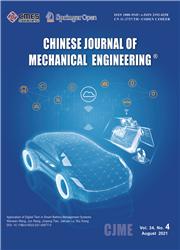On Energy Assessment of Titanium Alloys Belt Grinding Involving Abrasive Wear Effects
IF 4.5
2区 工程技术
Q1 Engineering
引用次数: 0
Abstract
Abstract Improved energy utilisation, precision, and quality are critical in the current trend of low-carbon green manufacturing. In this study, three abrasive belts were prepared at various wear stages and characterised quantitatively. The effects of abrasive belt wear on the specific grinding energy partition were investigated by evaluating robotic belt grinding of titanium plates. A specific grinding energy model based on subdivided tangential forces of cutting and sliding was developed for investigating specific energy and energy utilisation coefficient E UC . The surface morphology and Abbott–Firestone curves of the belts were introduced to analyse the experimental findings from the perspective of the micro cutting behaviour. The specific grinding energy increased with abrasive belt wear, especially when the belt was near the end of its life. Moreover, the belt wear could lead to a predominance change of sliding and chip formation energy. The highest E UC was observed in the middle of the belt life because of its retained sharp cutting edge and uniform distribution of the grit protrusion height. This study provides guidance for balancing the energy consumption and energy utilization efficiency of belt grinding.含磨料磨损效应的钛合金带磨削能量评价
在当前低碳绿色制造的趋势下,提高能源利用率、精度和质量至关重要。本研究制备了三种不同磨损阶段的磨粒带,并对其进行了定量表征。通过对钛板机器人带磨削的评价,研究了砂带磨损对比磨削能量分配的影响。为了研究比能和能量利用系数,建立了基于切削力和滑动力细分的磨削比能模型。引入了带的表面形貌和abbot - firestone曲线,从微切削行为的角度分析了实验结果。比磨能随着砂带磨损的增加而增加,特别是在砂带接近使用寿命时。此外,皮带磨损会导致滑动和切屑形成能量的优势变化。在皮带寿命的中期,由于其保留了锋利的切削刃和磨粒突出高度的均匀分布,因此观察到最高的E - UC。该研究为平衡带式磨削的能耗和能量利用效率提供了指导。
本文章由计算机程序翻译,如有差异,请以英文原文为准。
求助全文
约1分钟内获得全文
求助全文
来源期刊

Chinese Journal of Mechanical Engineering
ENGINEERING, MECHANICAL-
CiteScore
5.60
自引率
4.80%
发文量
3097
审稿时长
8 months
期刊介绍:
Chinese Journal of Mechanical Engineering (CJME) was launched in 1988. It is a peer-reviewed journal under the govern of China Association for Science and Technology (CAST) and sponsored by Chinese Mechanical Engineering Society (CMES).
The publishing scopes of CJME follow with:
Mechanism and Robotics, including but not limited to
-- Innovative Mechanism Design
-- Mechanical Transmission
-- Robot Structure Design and Control
-- Applications for Robotics (e.g., Industrial Robot, Medical Robot, Service Robot…)
-- Tri-Co Robotics
Intelligent Manufacturing Technology, including but not limited to
-- Innovative Industrial Design
-- Intelligent Machining Process
-- Artificial Intelligence
-- Micro- and Nano-manufacturing
-- Material Increasing Manufacturing
-- Intelligent Monitoring Technology
-- Machine Fault Diagnostics and Prognostics
Advanced Transportation Equipment, including but not limited to
-- New Energy Vehicle Technology
-- Unmanned Vehicle
-- Advanced Rail Transportation
-- Intelligent Transport System
Ocean Engineering Equipment, including but not limited to
--Equipment for Deep-sea Exploration
-- Autonomous Underwater Vehicle
Smart Material, including but not limited to
--Special Metal Functional Materials
--Advanced Composite Materials
--Material Forming Technology.
 求助内容:
求助内容: 应助结果提醒方式:
应助结果提醒方式:


